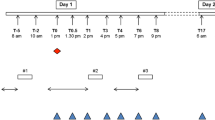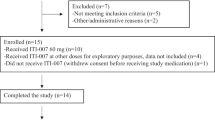Abstract
It has been suggested that a combined blockade of 5-HT2A and D2-dopamine receptors improves efficacy and reduces the risk for extrapyramidal symptoms when treating schizophrenic patients with antipsychotic drugs. ORG 5222 is a new potential anti-psychotic drug which has high affinity for 5-HT2A, D2-dopamine and α1 adrenergic receptors in vitro. The objective of this study was to examine if ORG 5222 occupies 5-HT2A and D2-dopamine receptors in human subjects in vivo. Central receptor occupancy was measured by positron emission tomography (PET) in three healthy subjects after sublingual administration of 100 μg ORG 5222. [11C]N-methylspiperone ([11C] NMSP) was the radioligand used to measure 5-HT2A receptor binding in the neocortex and [11C]raclopride to measure D2-dopamine receptor binding in the striatum. The 5-HT2A occupancy was 15–30% and the D2-dopamine receptor occupancy was 12–23%. The study confirms that ORG 5222 binds to 5-HT2A and D2-dopamine receptors in human brain. Since receptor occupancy of ORG 5222 is rather low, doses higher than 100 μg are suggested in future clinical trials to evaluate the antipsychotic drug effect of ORG 5222.
Similar content being viewed by others
Author information
Authors and Affiliations
Additional information
Received: 9 September 1996 / Final version: 2 January 1997
Rights and permissions
About this article
Cite this article
Andrée, B., Halldin, C., Vries, Md. et al. Central 5-HT2A and D2 dopamine receptor occupancy after sublingual administration of ORG 5222 in healthy men. Psychopharmacology 131, 339–345 (1997). https://doi.org/10.1007/s002130050301
Issue Date:
DOI: https://doi.org/10.1007/s002130050301




